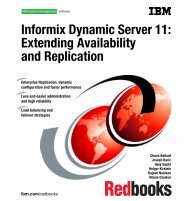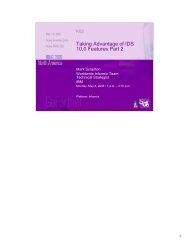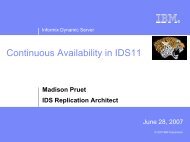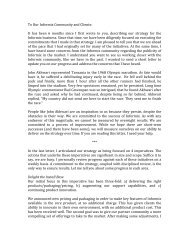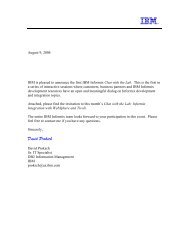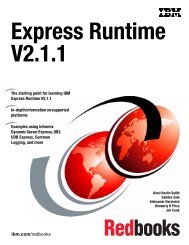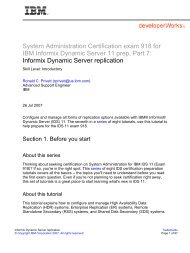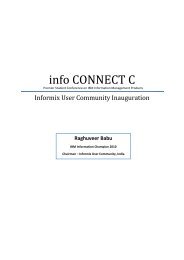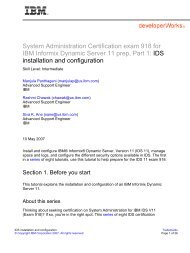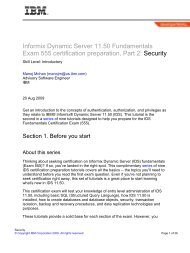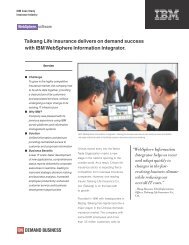CCSID 102 â What's a CCSID and why do I care?
CCSID 102 â What's a CCSID and why do I care?
CCSID 102 â What's a CCSID and why do I care?
You also want an ePaper? Increase the reach of your titles
YUMPU automatically turns print PDFs into web optimized ePapers that Google loves.
Wednesday, March 29, 2006<br />
C02<br />
<strong>CCSID</strong> <strong>102</strong> –<br />
What’s a <strong>CCSID</strong> <strong>and</strong><br />
<strong>why</strong> <strong>do</strong> I <strong>care</strong>?<br />
Christopher J. Crone<br />
IBM/DB2 for z/OS Development<br />
Monday, May 8th, 2006 • 1:00 p.m. – 2:10 p.m.<br />
Platform: z/OS
Wednesday, March 29, 2006<br />
IBM Software Group | DB2 information management software<br />
Presentation Topics<br />
• How <strong>do</strong>es DB2 know the <strong>CCSID</strong> of My data<br />
• When <strong>do</strong>es DB2 convert<br />
• Character Based Functions<br />
• Queries with more than one Encoding<br />
• Putting it all together – Examples<br />
DDL<br />
SQL<br />
Utilities<br />
2
Wednesday, March 29, 2006<br />
IBM Software Group | DB2 Information Management Software<br />
Terminology<br />
• For the purposes of this presentation<br />
ASCII - all ASCII <strong>CCSID</strong>s that DB2 currently supports<br />
EBCDIC - all EBCDIC <strong>CCSID</strong>s that DB2 currently supports<br />
UNICODE - UTF-8 or UTF-16<br />
Encoding Scheme<br />
• ASCII, EBCDIC or Unicode<br />
<strong>CCSID</strong> – Coded Character Set Identifier (used by DB2 to tag string<br />
data)<br />
• Two-byte, unsigned binary integer identifying a specific set of<br />
encoding scheme <strong>and</strong> one or more pairs of character sets (CS)<br />
<strong>and</strong> code pages (CP)<br />
<strong>CCSID</strong> set<br />
• The single byte <strong>CCSID</strong> value (SBCS), mixed <strong>CCSID</strong> value <strong>and</strong><br />
<strong>do</strong>uble byte <strong>CCSID</strong> value (DBCS) associated with a particular<br />
encoding scheme<br />
Multiple <strong>CCSID</strong> Sets<br />
• When two or more <strong>CCSID</strong> sets contain different <strong>CCSID</strong> values<br />
for one or more values in a set (SBCS, Mixed or DBCS).
Wednesday, March 29, 2006<br />
®<br />
IBM Software Group<br />
How <strong>do</strong>es DB2 know the <strong>CCSID</strong> of my data?
IBM Software Group | DB2 information management software<br />
Installation (continued)<br />
•Information from DSNTIPF ends up in Job DSNTIJUZ<br />
Mixed System<br />
Non-Mixed System<br />
DSNHDECM AS<strong>CCSID</strong>=1088,<br />
AM<strong>CCSID</strong>=949,<br />
AG<strong>CCSID</strong>=951,<br />
S<strong>CCSID</strong>=833,<br />
M<strong>CCSID</strong>=933,<br />
G<strong>CCSID</strong>=834,<br />
US<strong>CCSID</strong>=367,<br />
UM<strong>CCSID</strong>=1208,<br />
UG<strong>CCSID</strong>=1200,<br />
ENSCHEME=EBCDIC,<br />
APPENSCH=EBCDIC,<br />
MIXED=YES<br />
END<br />
DSNHDECM AS<strong>CCSID</strong>=819,<br />
AM<strong>CCSID</strong>=65534,<br />
AG<strong>CCSID</strong>=65534,<br />
S<strong>CCSID</strong>=37,<br />
M<strong>CCSID</strong>=65534,<br />
G<strong>CCSID</strong>=65534,<br />
US<strong>CCSID</strong>=367,<br />
UM<strong>CCSID</strong>=1208,<br />
UG<strong>CCSID</strong>=1200,<br />
ENSCHEME=EBCDIC,<br />
APPENSCH=EBCDIC,<br />
MIXED=NO<br />
END<br />
5<br />
The information from panel DSNTIPF flows to Job DSNTIJUZ.<br />
In the case on the Left, we have a Mixed = Yes system that is<br />
set up to support Korea. The ASCII <strong>and</strong> EBCDIC system<br />
<strong>CCSID</strong>s that actually would have been specified on panel<br />
DSNTIPF, to result in this specification, would have been 949<br />
<strong>and</strong> 833.<br />
For mixed systems, <strong>and</strong> for the Unicode <strong>CCSID</strong>, the Mixed<br />
<strong>CCSID</strong> is specified on install panel DSNTIPF <strong>and</strong> DB2 will pick<br />
the corresponding Single byte <strong>and</strong> Graphic (Double Byte)<br />
<strong>CCSID</strong>s.<br />
In the case on the Right, we have a Mixed = No system that is<br />
set up to support US English.<br />
Note that the user specified 819 <strong>and</strong> 37 for the ASCII <strong>and</strong><br />
EBCDIC Single byte <strong>CCSID</strong>s <strong>and</strong> that DB2 used the value<br />
65534 for the ASCII <strong>and</strong> EBCDIC Mixed <strong>and</strong> Graphic (Double<br />
byte) <strong>CCSID</strong>s. 65534 is a reserved value that means no<br />
<strong>CCSID</strong>.<br />
Also note that the Default Encoding <strong>and</strong> Default Application<br />
Encoding also flow to this job.<br />
Note there is a bug in DSNTIJUZ <strong>and</strong> DSNHDECM - These ship<br />
with <strong>CCSID</strong> 500 as default.
IBM Software Group | DB2 information management software<br />
Installation<br />
Specification of <strong>CCSID</strong>s is performed at installation via install Panel<br />
DSNTIPF<br />
DSNTIPF INSTALL DB2 -APPLICATION PROGRAMMING DEFAULTS PANEL 1<br />
===>_<br />
Enter data below:<br />
1 LANGUAGE DEFAULT ===> IBMCOB ASM,C,CPP,COBOL,COB2,IBMCOB,FORTRAN,PLI<br />
2 DECIMAL POINT IS ===> . .or ,<br />
3 MINIMUM DIVIDE SCALE ===> NO NO or YES for a minimum of 3 digits<br />
to right of decimal after division<br />
4 STRING DELIMITER ===> DEFAULT DEFAULT,"or '(COBOL or COB2 only)<br />
5 SQL STRING DELIMITER ===> DEFAULT DEFAULT,"or '<br />
6 DIST SQL STR DELIMTR ===> ' 'or "<br />
7 MIXED DATA ===> NO NO or YES for mixed DBCS data<br />
8 EBCDIC <strong>CCSID</strong> ===> 0 <strong>CCSID</strong> of your SBCS or MIXED DATA<br />
9 ASCII <strong>CCSID</strong> ===> 0 <strong>CCSID</strong> of SBCS or mixed data.<br />
10 Unicode <strong>CCSID</strong> ===> 1208 <strong>CCSID</strong> of Unicode UTF-8 data.<br />
11 DEF ENCODING SCHEME ===> EBCDIC EBCDIC, ASCII, or UNICODE<br />
12 LOCALE LC_CTYPE ===><br />
13 APPLICATION ENCODING ===> EBCDIC EBCDIC, ASCII, UNICODE ccsid (1-65533)<br />
14 DECIMAL ARITHMETIC ===> DEC15 DEC15,DEC31,15,31<br />
15 USE FOR DYNAMICRULES ===> YES YES or NO<br />
16 DESCRIBE FOR STATIC ===> NO Allow DESCRIBE for STATIC SQL.NO or YES.<br />
6<br />
Install panel DSNTIPF is used to specify <strong>CCSID</strong> information<br />
Options 8,9, <strong>and</strong> 10 are where the <strong>CCSID</strong>s for the three<br />
encoding schemes are specified.<br />
Notice that ASCII <strong>and</strong> EBCDIC <strong>CCSID</strong>s are initialized to 0 <strong>and</strong><br />
the Unicode <strong>CCSID</strong> is initialized to 1208<br />
The ASCII <strong>and</strong> EBCDIC <strong>CCSID</strong>s are not pre-filled, these values<br />
needs to be set by the customer.<br />
The EBCDIC should be set to the <strong>CCSID</strong> that the customer's<br />
3270 emulators, CICS, <strong>and</strong> IMS transactions use.<br />
The ASCII value should be set to the <strong>CCSID</strong> that is most<br />
commonly used by workstations in the customer shop (1252 for<br />
example).<br />
The Unicode value is pre-filled with 1208 cannot be changed.<br />
This value specifies the mixed <strong>CCSID</strong> for Unicode tables.<br />
Other things to note on this page<br />
Option 11 - This specifies the default encoding scheme for<br />
Objects created in the DB2 subsystem.<br />
Option 13 - This option specifies the default application<br />
encoding. Changing this valuse should be <strong>do</strong>ne with great <strong>care</strong>.
IBM Software Group | DB2 Information Management Software<br />
DB2 Metadata – Where DB2 looks for information<br />
<strong>CCSID</strong>s are stored in the following places<br />
SYSIBM.SYSDATABASE (V5)<br />
SYSIBM.SYSCOLUMNS<br />
- FOREIGNKEY (V2.3) - subtype information<br />
- <strong>CCSID</strong> (V8)<br />
SYSIBM.SYSPACKAGE (V7) – Application Encoding<br />
SYSIBM.SYSPARMS (V6)<br />
SYSIBM.SYSPLAN (V7) – Application Encoding<br />
SYSIMB.SYSROUTINES (V8)<br />
SYSIBM.SYSTABLES (V8)<br />
SYSIBM.SYSTABLESPACE (V5)<br />
SYSIBM.SYSVTREE (V5)<br />
Plans <strong>and</strong> Packages (SCT02 <strong>and</strong> SPT01) – No external<br />
Directory (DSNDB01) (V5) – No external<br />
DECP (V2.3)<br />
BSDS (V8)<br />
In ENCODING_SCHEME column of - Stored as 'A', 'E', 'U', or blank (default)<br />
SYSIBM.SYSDATATYPES<br />
SYSIBM.SYSDATABASE<br />
SYSIBM.SYSPARMS<br />
SYSIBM.SYSTABLESPACE<br />
SYSIBM.SYSTABLES<br />
Once we've specified <strong>CCSID</strong>s for our system, what <strong>do</strong>es DB2 <strong>do</strong><br />
with them?<br />
DB2 stores <strong>CCSID</strong>s in the Catalog, the directory, in bound<br />
statements, the directory, <strong>and</strong> of course the DECP<br />
The value stored in these areas depends on what release of DB2<br />
was used to create the object, <strong>and</strong> the value in the DECP at the<br />
time the object was created.<br />
If a value is 0, it is assumed that the object is EBCDIC.<br />
In general, DB2 <strong>do</strong>es not support changing of a <strong>CCSID</strong> once it is<br />
specified in a DECP<br />
The exceptions are<br />
Changing from 0 to a valid value<br />
Changing from a <strong>CCSID</strong> that <strong>do</strong>es not support the EURO symbol<br />
to a <strong>CCSID</strong> that supports the EURO symbol (37 -> 1140 for<br />
instance).<br />
Note that this sort of change requires special, disruptive,<br />
changes <strong>and</strong> should be undertaken only after the <strong>do</strong>cumentation<br />
has been read <strong>and</strong> the process is thoroughly understood.<br />
Encoding enformation is also stored in some catalog tables
Wednesday, March 29, 2006<br />
®<br />
IBM Software Group<br />
When Does DB2 Convert?
IBM Software Group | DB2 Information Management Software<br />
When <strong>do</strong>es conversion occur?<br />
Local<br />
Generally, conversion <strong>do</strong>es not occur for local applications<br />
When dealing with ASCII/Unicode tables<br />
When specified by application<br />
<strong>CCSID</strong> Override in SQLDA (V2.3)<br />
Declare Variable (V7)<br />
Application Encoding Bind Option (V7)<br />
Current Application Encoding Special Register (V7)<br />
ODBC/JDBC/SQLJ<br />
Remote<br />
Automatically when needed<br />
DRDA Receiver Makes Right<br />
There are no hard <strong>and</strong> fast rules as to when a<br />
conversion occurs. The short answer is that conversion<br />
occurs when necessary.<br />
Some of the cases when we <strong>do</strong> conversion are listed<br />
here.
Wednesday, March 29, 2006<br />
IBM Software Group | DB2 Information Management Software<br />
Local Data – The Wrong Way<br />
Ø<br />
SPUFI or QMF – <strong>CCSID</strong> 37<br />
Þ<br />
(US) @ = x’7C’<br />
§<br />
DB2 V8 Server<br />
@<br />
EBCDIC <strong>CCSID</strong> 37<br />
@<br />
@<br />
@<br />
@<br />
Þ<br />
§<br />
Ø<br />
Ş<br />
@<br />
@<br />
CICS – <strong>CCSID</strong> 277<br />
(Denmark) @ = x’80’<br />
@<br />
IMS = <strong>CCSID</strong> <strong>102</strong>6<br />
(Turkey) @ = x’AE’<br />
§<br />
Ø<br />
@<br />
Þ<br />
@<br />
§<br />
@<br />
@<br />
§<br />
Ø<br />
COBOL Batch - <strong>CCSID</strong> 273<br />
(Germany) @ = x’B5’<br />
Þ<br />
@<br />
Ø<br />
In this example, assume that all the clients are referencing an EBCDIC table<br />
(<strong>CCSID</strong> 37 in this case). Each of the local applications is attempting to insert an<br />
“@” into a DB2 table. In general, the results will be incorrect unless DB2<br />
“knows” that the data coming from the CICS, IMS, <strong>and</strong> COBOL applications is<br />
not <strong>CCSID</strong> 37. There are various ways of the application to tell DB2 the <strong>CCSID</strong><br />
of the data that they are giving DB2 (in input host variables) or they want to<br />
receive from DB2 (in output host variables). These are:<br />
-<strong>CCSID</strong> overrides in the SQLDA – when using a descriptor<br />
-DECLARE VARIABE – precompiler directive<br />
-ENCODING bind option<br />
-APPLICATION ENCODNG special register
Wednesday, March 29, 2006<br />
IBM Software Group | DB2 Information Management Software<br />
Local Data – The Right Way<br />
@<br />
SPUFI or QMF – <strong>CCSID</strong> 37<br />
@<br />
(US) @ = x’7C’<br />
@<br />
DB2 V8 Server<br />
@<br />
EBCDIC <strong>CCSID</strong> 37<br />
@<br />
@<br />
@<br />
@<br />
@<br />
@<br />
@<br />
@<br />
@<br />
@<br />
@<br />
CICS – <strong>CCSID</strong> 277<br />
(Denmark) @ = x’80’<br />
<strong>CCSID</strong> override in SQLDA<br />
‘SQLDA+’<br />
SQLNAME Length = 8<br />
SQLNAME = x’00000115’<br />
IMS = <strong>CCSID</strong> <strong>102</strong>6<br />
(Turkey) @ = x’AE’<br />
ENCODING(<strong>102</strong>6)<br />
@<br />
@<br />
@<br />
@<br />
@<br />
@<br />
COBOL Batch - <strong>CCSID</strong> 273<br />
(Germany) @ = x’B5’<br />
EXEC SQL DECLARE :hv<br />
VARIABLE <strong>CCSID</strong> 273;<br />
@<br />
@<br />
@<br />
In this example, assume that all the clients are referencing an EBCDIC table<br />
(<strong>CCSID</strong> 37 in this case). Each of the local applications is attempting to insert an<br />
“@” into a DB2 table. In general, the results will be incorrect unless DB2<br />
“knows” that the data coming from the CICS, IMS, <strong>and</strong> COBOL applications is<br />
not <strong>CCSID</strong> 37.<br />
In this case:<br />
The ENCODING bind option is used to let DB2 know the <strong>CCSID</strong> of the<br />
application inserting the data from Turkey.<br />
DECLARE VARIABLE is used by the batch job inserting data from<br />
Germany<br />
<strong>CCSID</strong> overrides are used in the CICS application inserting data from<br />
Denmark<br />
The result is that the data is inserted correctly, <strong>and</strong> when each application fetches<br />
the data that was just inserted, it is represented correctly (each client sees the<br />
correct data).
Wednesday, March 29, 2006<br />
IBM Software Group | DB2 Information Management Software<br />
DB2 <strong>and</strong> friends…<br />
DB2 for z/OS Server<br />
This picture is showing that data <strong>do</strong>es not have to come into DB2 through a<br />
terminal emulator to cause problems.<br />
All character data has a <strong>CCSID</strong>. That <strong>CCSID</strong> may be implicit or it may be<br />
explicit, but there is a <strong>CCSID</strong> for the data.<br />
In this case, you might have data coming through a (golden) gateway, a tape,<br />
electronic computer to computer transfer (such as FTP), or LOAD. In every case<br />
there is a <strong>CCSID</strong> associated with the data <strong>and</strong> if DB2 <strong>do</strong>es not know what the<br />
<strong>CCSID</strong> is, it may treat the data incorrectly.
Wednesday, March 29, 2006<br />
®<br />
IBM Software Group<br />
Character Based Functions
Wednesday, March 29, 2006<br />
IBM Software Group | DB2 Information Management Software<br />
Character Based Functions (PQ88784)<br />
• New functions<br />
CHARACTER_LENGTH<br />
POSITION<br />
SUBSTRING<br />
• Updated Functions<br />
CHAR<br />
CLOB<br />
DBCLOB<br />
GRAPHIC<br />
INSERT<br />
LEFT<br />
LOCATE<br />
RIGHT<br />
VARCHAR<br />
VARGRAPHIC<br />
• CAST Specification<br />
Changes to enable specification of Code Units
Wednesday, March 29, 2006<br />
IBM Software Group | DB2 Information Management Software<br />
Character Based Functions (sample syntax)
Wednesday, March 29, 2006<br />
IBM Software Group | DB2 Information Management Software<br />
Character Based Functions - Example<br />
Assume that NAME is a VARCHAR(128) column, encoded in Unicode<br />
UTF-8, that contains 'Jürgen'. The following query:<br />
SELECT CHARACTER_LENGTH(NAME,CODEUNITS32)<br />
FROM T1 WHERE NAME = ’Jürgen’;<br />
or<br />
SELECT CHARACTER_LENGTH(NAME,CODEUNITS16)<br />
FROM T1 WHERE NAME = ’Jürgen’;<br />
returns the value 6. A similar query:<br />
SELECT CHARACTER_LENGTH(NAME,OCTETS)<br />
FROM T1 WHERE NAME = ’Jürgen’;<br />
or<br />
SELECT LENGTH(NAME)<br />
FROM T1 WHERE NAME = ’Jürgen’;<br />
returns the value 7.
Wednesday, March 29, 2006<br />
IBM Software Group | DB2 Information Management Software<br />
LEFT <strong>and</strong> RIGHT Examples<br />
LEFT<br />
Statement<br />
LEFT(‘Jürgen’,2,CODEUNITS32)<br />
LEFT(‘Jürgen’,2,CODEUNITS16)<br />
LEFT(‘Jürgen’,2,OCTETS)<br />
LEFT(‘Jürgen’,2)<br />
RIGHT<br />
Statement<br />
RIGHT(‘Jürgen’,5,CODEUNITS32)<br />
RIGHT(‘Jürgen’,5,CODEUNITS16)<br />
RIGHT(‘Jürgen’,5,OCTETS)<br />
RIGHT(‘Jürgen’,5)<br />
Result<br />
’Jü’ -- x’4AC3BC’<br />
’Jü’ -- x’4AC3BC’<br />
’J ’ -- x’4A20’ a truncated string<br />
’J?’ -- x’4AC3’ The letter ‘J’ <strong>and</strong> a Partial character*<br />
Result<br />
’ürgen’ -- x’C3BC7267656E’<br />
’ürgen’ -- x’C3BC7267656E’<br />
’ rgen’ -- x’207267656E’ a truncated string<br />
’ ?rgen’ -- x’BC7267656E’ a partial character<br />
followed by ‘rgen’*<br />
*If conversion occurs with on a string with a partial character, SQLCODE -330 results.<br />
LEFT <strong>and</strong> RIGHT operate in a similar manner.<br />
In these examples, CODEUNITS32 <strong>and</strong> CODEUNITS16 return the same results.<br />
When OCTETS is specified, an a partial character would result, the PAD<br />
character is used.<br />
When no units are specified, the behavior is similar to that of OCTETS (byte<br />
based), but partial characters can result.
Wednesday, March 29, 2006<br />
IBM Software Group | DB2 Information Management Software<br />
SUBSTRING<br />
Function ... Returns ...<br />
SUBSTRING(‘Jürgen',1,2,CODEUNITS32) ’Jü’ -- x’4AC3BC’<br />
SUBSTRING(‘Jürgen',1,2,CODEUNITS16) ’Jü’ -- x’4AC3BC’<br />
SUBSTRING(‘Jürgen',1,2,OCTETS) ’J ’ -- x’4A20’ - a truncated string<br />
SUBSTR(‘Jürgen',1,2)<br />
‘J?’ –x’4AC3’– a partial character<br />
SUBSTRING(‘Jürgen',8,CODEUNITS16) a zero-length string<br />
SUBSTRING(‘Jürgen',8,4,OCTETS) a zero-length string<br />
SUBSTRING(’ABCDEFG’,-2,2,OCTETS)<br />
SUBSTRING(’ABCDEFG’,-2,4,OCTETS)<br />
SUBSTRING(’ABCDEFG’,-2,5,OCTETS)<br />
SUBSTRING(’ABCDEFG’,-2,OCTETS)<br />
SUBSTRING(’ABCDEFG’,0,1,OCTETS)<br />
a zero-length string<br />
’A’<br />
’AB’<br />
’ABCDEFG’<br />
a zero-length string<br />
Let C be the value of the string-expression, let LC be the length in<br />
characters of C, <strong>and</strong> let S be the value of the start. v If length is<br />
The first <strong>and</strong> second examples return the same value because even<br />
though ‘ü’ is a multi-byte character in UTF-8, it is one CODEUNITS32 or<br />
CODEUNITS16 codepoint.<br />
In the third example OCTETS is specified <strong>and</strong> since a partial character would<br />
have resulted, truncation occurs on the partial character <strong>and</strong> a pad character is<br />
returned in place of the partial character.<br />
In the fourth example, we are using SUBSTR, not SUBSTRING. SUBSTR is<br />
byte based <strong>and</strong> will return partial characters. As mentioned previously if<br />
conversion occurs on a string with a partial character, -330 will result.<br />
specified, let L be the value of <strong>and</strong> let E be S+L.<br />
Otherwise, let E be the larger of LC + 1 <strong>and</strong> S. v If either C, S, or L is the<br />
null value, the result of the function is the null value. v If E is less than S,<br />
an exception condition is raised: data exception — substring error. v<br />
Otherwise: – If S is greater than LC or if E is less than 1 (one), the result of<br />
the function is a zero-length string. – Otherwise: - Let S1 be the larger of S<br />
<strong>and</strong> 1 (one). Let E1 be the smaller of E <strong>and</strong> LC+1. Let L1 be E1–S1. - The<br />
result of the function is a character string that contains the L1 characters of<br />
C starting at character number S1 in the same order that the characters<br />
appear in C.
Wednesday, March 29, 2006<br />
IBM Software Group | DB2 Information Management Software<br />
Example where CODEUNITS16 <strong>and</strong> CODEUNITS32 differ<br />
Unicode value \u1D400 - ’A’ MATHEMATICAL BOLD CAPITAL A<br />
UTF-8<br />
UTF-16<br />
UTF-32<br />
X'F09D9080'<br />
X'D835DC00'<br />
X'0001D400'<br />
Assume that C1 is a VARCHAR(10) column, encoded in Unicode UTF-8, <strong>and</strong> that table<br />
T1 contains one row with the value of the mathematical bold capital A (X'F09D9080').<br />
The following similar queries return different answers:<br />
SELECT CHARACTER_LENGTH(C1,CODEUNITS32) FROM T1; -- Returns 1<br />
SELECT CHARACTER_LENGTH(C1,CODEUNITS16) FROM T1; -- Returns 2<br />
SELECT CHARACTER_LENGTH(C1,OCTETS) FROM T1; -- Returns 4<br />
The following similar queries return different answers:<br />
SELECT HEX(SUBSTRING(C1,1,1,CODEUNITS32)) FROM T1; -- Returns X'F09D9080'<br />
SELECT HEX(SUBSTRING(C1,1,1,CODEUNITS16)) FROM T1; -- Returns X'20'<br />
SELECT HEX(SUBSTRING(C1,1,2,CODEUNITS16)) FROM T1; -- Returns X'F09D9080'<br />
SELECT HEX(SUBSTRING(C1,1,1,OCTETS)) FROM T1; -- Returns X'20‘ (blank)<br />
SELECT HEX(SUBSTR(C1,1,1)) FROM T1;<br />
-- Returns X'F0'<br />
For many characters, specifying CODEUNITS16 <strong>and</strong> CODEUNITS32 on a BIF<br />
<strong>do</strong>es not matter. However, when supplementary characters (sometimes also<br />
called surrogate characters) are used, the results can be different.
Wednesday, March 29, 2006<br />
®<br />
IBM Software Group<br />
Queries with more than one encoding
Wednesday, March 29, 2006<br />
IBM Software Group | DB2 Information Management Software<br />
Multiple <strong>CCSID</strong> Sets per SQL Statement<br />
While there are no syntax changes to allow multiple <strong>CCSID</strong><br />
sets, the following SQL statements may be affected.<br />
ALTER TABLE & ALTER TABLE ADD (materialized query table)<br />
CREATE TABLE (materialized query table)<br />
CREATE TABLE LIKE view-table<br />
CREATE GLOBAL TEMPORARY TABLE LIKE view-table<br />
CREATE VIEW<br />
DECLARE GLOBAL TEMPORARY TABLE AS (fullselect) DEFINITION ONLY<br />
DECLARE GLOBAL TEMPORARY TABLE LIKE view-table<br />
DELETE<br />
INSERT<br />
SELECT<br />
SELECT INTO<br />
UPDATE<br />
Scalar fullselect expression<br />
The statements listed above may have their behavior<br />
affected when data from more than one encoding is<br />
processed as part of the execution of the statement
Wednesday, March 29, 2006<br />
IBM Software Group | DB2 Information Management Software<br />
Multiple <strong>CCSID</strong> Sets - Example 1:<br />
SELECT a.name, a.creator, b.charcol, 'ABC',<br />
:hvchar, X'C1C2C3'<br />
FROM sysibm.systables a,<br />
ebcdictable b<br />
WHERE a.name = b.name AND<br />
b.name > 'B' AND<br />
a.creator = 'SYSADM'<br />
ORDER BY b.name;<br />
In the above example, since both tables have the<br />
same system EBCDIC <strong>CCSID</strong> set, the comparisons<br />
are <strong>do</strong>ne in EBCDIC <strong>and</strong> the result data is EBCDIC.<br />
To maintain compatibility with previous releases, statements that<br />
<strong>do</strong> not reference objects with more than one <strong>CCSID</strong> set, will<br />
continue to use the old rules.<br />
•For compatibility with prior releases:<br />
•IF an SQL statement which references table objects with<br />
only one <strong>CCSID</strong> set<br />
•THEN the results will continue to have the same result<br />
encoding scheme (<strong>CCSID</strong> set) as the table objects<br />
<strong>and</strong> basic semantics.<br />
•All string objects <strong>and</strong> special registers in the SQL statement are<br />
converted to this result encoding scheme (<strong>CCSID</strong> set) vs. using<br />
the application encoding scheme like multiple <strong>CCSID</strong> set SQL<br />
statements.<br />
In this example, all the tables reference a single encoding<br />
scheme.<br />
The results of this query will be EBCDIC.
IBM Software Group | DB2 Information Management Software<br />
Multiple <strong>CCSID</strong> Sets - Example 1 (continued)<br />
SELECT a.name, a.creator, b.charcol, 'ABC',<br />
:hvchar, X'C1C2C3'<br />
FROM sysibm.systables a,<br />
ebcdictable b<br />
WHERE a.name = b.name AND<br />
b.name > 'B' AND<br />
a.creator = 'SYSADM'<br />
ORDER BY b.name;<br />
Result or Evaluated:<br />
EBCDIC<br />
Unicode<br />
Application Encoding Scheme<br />
Assuming a Unicode catalog, the result will contain<br />
multiple <strong>CCSID</strong>s <strong>and</strong> the comparisons <strong>and</strong> ordering<br />
will be dependent on the context.<br />
In this example, where we have a Unicode catalog,<br />
some columns are EBCDIC <strong>and</strong> others are Unicode.<br />
Literal values are interpreted using the Application<br />
Encoding option in effect.<br />
Queries that cross encoding schemes are allowed once<br />
ENFM (Enabling New Function Mode) is entered. This is<br />
to ensure that applications that access the catalog<br />
continue to function.
Wednesday, March 29, 2006<br />
IBM Software Group | DB2 Information Management Software<br />
SQL statements with multiple <strong>CCSID</strong> sets<br />
Comparison <strong>and</strong> resulting data types for multiple <strong>CCSID</strong> sets...<br />
If an expression or comparison involves two strings which contain columns<br />
with different <strong>CCSID</strong> sets,<br />
Drive to Unicode if necessary<br />
WHERE T1.C1 = T2.C1<br />
If an expression or comparison involves two strings with different <strong>CCSID</strong><br />
sets where only one of them contains a column,<br />
Drive to the column's <strong>CCSID</strong> set<br />
WHERE T1.C1 = X'C1C2'<br />
If an expression or comparison involves two strings with different <strong>CCSID</strong><br />
sets <strong>and</strong> neither contains a column,<br />
Drive to Unicode<br />
WHERE GX'42C142C2' = ‘ABC‘ -- GX literal <strong>and</strong> ‘ABC’ are different <strong>CCSID</strong>s<br />
String constants <strong>and</strong> special registers in a context by themselves use the<br />
application encoding scheme<br />
SELECT ‘ABC‘ FROM T1 . . .<br />
Here are some examples of how the new DB2 rules for<br />
multiple <strong>CCSID</strong> sets work<br />
-In the first case we have two columns being compared<br />
– in this case, drive to Unicode if they are not already<br />
Unicode<br />
-In the second case, we drive to the column <strong>CCSID</strong> set<br />
-In the third case, neither side is a column, so drive to<br />
Unicode<br />
-In the fourth case we use the APPLICATION<br />
ENCODING SCHEME – the thought here is that the<br />
application is providing the string, we should interpret<br />
the string in the same encoding as the application.
Wednesday, March 29, 2006<br />
IBM Software Group | DB2 Information Management Software<br />
Multiple <strong>CCSID</strong> Sets – A closer look<br />
CREATE TABLE T<strong>CCSID</strong>U (CU1 VARCHAR(12)) <strong>CCSID</strong> UNICODE;<br />
CREATE TABLE T<strong>CCSID</strong>E (CE1 VARCHAR(12)) <strong>CCSID</strong> EBCDIC;<br />
INSERT INTO T<strong>CCSID</strong>U VALUES (‘Jürgen');<br />
INSERT INTO T<strong>CCSID</strong>E VALUES ('Jürgen');<br />
SELECT LENGTH(A.CU1) AS L1, HEX(A.CU1) AS H1,<br />
LENGTH(B.CE1) AS L2, HEX(B.CE1) AS H2<br />
FROM T<strong>CCSID</strong>U A, T<strong>CCSID</strong>E B WHERE A.CU1 = B.CE1;<br />
Returns<br />
+-------------------------------------------------+<br />
| L1 | H1 | L2 | H2 |<br />
+-------------------------------------------------+<br />
1_| 7 | 4AC3BC7267656E | 6 | D1DC99878595 |<br />
+-------------------------------------------------+<br />
In this example, you can see that up until the data is returned to the application,<br />
the data from T<strong>CCSID</strong>U is Unicode, <strong>and</strong> the data from T<strong>CCSID</strong>E is EBCDIC. At<br />
the point the data is returned to the application (copied from DB2 to the<br />
applications host variables), conversion will be performed to the <strong>CCSID</strong> specified<br />
by the application (either implicitly or explicitly). In this case, since we are<br />
returning the HEX representation of the data, we really <strong>do</strong>n’t convert the data, we<br />
convert the hex representation of the data (which will always be composed of<br />
characters between 0-9 <strong>and</strong> A-F).<br />
The result is the same for all Join methods. For Sort Merge Join (SMJ), we<br />
convert the T<strong>CCSID</strong>E.CE1 to Unicode before sorting. In the sort workfile, we<br />
carry both the EBCIDC version of the string (to return to the application), <strong>and</strong> the<br />
Unicode version of the string (for comparison processing in the Join). As a result,<br />
the size of workfiles can increase when EBCDIC <strong>and</strong> Unicode tables are joined<br />
(as compared to joining two EBCDIC or two Unicode tables). Additionally, it is<br />
possible that SQLCODE -136 or -670 may be issued.
Wednesday, March 29, 2006<br />
IBM Software Group | DB2 Information Management Software<br />
Multiple <strong>CCSID</strong> – Performance Considerations<br />
CREATE TABLE ET1(C1 VARCHAR(8) FOR SBCS DATA) <strong>CCSID</strong> EBCDIC;<br />
CREATE TABLE ET2(C1 VARCHAR(8) FOR SBCS DATA) <strong>CCSID</strong> EBCDIC;<br />
CREATE TABLE UT3(C1 VARCHAR(8) FOR SBCS DATA) <strong>CCSID</strong> UNICODE;<br />
EXPLAIN ALL SET QUERYNO = 1 FOR SELECT ET1.C1 FROM ET1<br />
WHERE ET1.C1 IN (SELECT ET2.C1 FROM ET2 WHERE ET1.C1 = ET2.C1);<br />
EXPLAIN ALL SET QUERYNO = 2 FOR SELECT ET1.C1 FROM ET1<br />
WHERE ET1.C1 IN (SELECT UT3.C1 FROM UT3 WHERE ET1.C1 = UT3.C1);<br />
+----------------------------------------------------------+<br />
| QUERYNO | QBLOCKNO | METHOD | TNAME | TABNO | ACCESSTYPE |<br />
+----------------------------------------------------------+<br />
1_| 1 | 1 | 0 | ET1 | 1 | R |<br />
2_| 1 | 1 | 2 | ET2 | 2 | R |<br />
3_| 2 | 1 | 0 | ET1 | 1 | R |<br />
4_| 2 | 2 | 0 | UT3 | 2 | R |<br />
+----------------------------------------------------------+<br />
In this example, we have three tables ET1 <strong>and</strong> ET2 are EBCDIC tables, <strong>and</strong> UT3<br />
is a Unicode table.<br />
The two queries are identical, except the second query has UT3 where the first<br />
query has ET2.<br />
Note that table UT3 isn’t really even using Unicode data (it is defined as “FOR<br />
SBCS DATA” which means that the data will be 7-bit ASCII).<br />
When two EBCDIC tables are involved, as in QUERYNO=1, we are able to<br />
transform the query into a join. In the second example, the transformation to a<br />
join did not take place, as a result the second query may perform slower than the<br />
first query.<br />
This is a very simple example that demonstrates the ramifications to performance<br />
of multiple <strong>CCSID</strong> statements.
Wednesday, March 29, 2006<br />
IBM Software Group | DB2 Information Management Software<br />
New EXPLAIN tables / columns - PLAN_TABLE<br />
Column Name <strong>and</strong> Type<br />
TABLE_ENCODE CHAR(1)<br />
TABLE_S<strong>CCSID</strong> FIXED(16)<br />
TABLE_M<strong>CCSID</strong> FIXED(16)<br />
TABLE_D<strong>CCSID</strong> FIXED(16)<br />
Description<br />
Indicates the encoding scheme of the<br />
statement. If the statement represents<br />
a single <strong>CCSID</strong> set, then the column will<br />
contain 'E' for EBCDIC, 'A' for ASCII, or<br />
'U' for Unicode. If the statement is a<br />
multiple <strong>CCSID</strong> set statement, then the<br />
column will be set to 'M' for multiple<br />
<strong>CCSID</strong> sets.<br />
The SBCS <strong>CCSID</strong> value of the table or<br />
zero if the TABLE_ENCODE column is 'M'<br />
The Mixed <strong>CCSID</strong> value of the table or<br />
zero if the TABLE_ENCODE column is 'M'<br />
The DBCS <strong>CCSID</strong> value of the table or<br />
zero if the TABLE_ENCODE column is 'M'<br />
The table above shows the changes to the PLAN_TABLE<br />
to support multiple <strong>CCSID</strong>s in a statement
Wednesday, March 29, 2006<br />
IBM Software Group | DB2 Information Management Software<br />
New EXPLAIN tables / columns --<br />
DSN_STATEMNT_TABLE<br />
Column Name <strong>and</strong> Type<br />
STMT_ENCODE CHAR(1)<br />
Description<br />
Indicates the encoding scheme of the<br />
statement. If the statement<br />
represents a single <strong>CCSID</strong> set, then the<br />
column will contain 'E' for EBCDIC, 'A'<br />
for ASCII, or 'U' for Unicode. If the<br />
statement is a multiple <strong>CCSID</strong> set<br />
statement, then the column will be set<br />
to 'M' for multiple <strong>CCSID</strong> sets.<br />
The table above shows the changes to the<br />
DSN_STATEMNT_TABLE to support multiple <strong>CCSID</strong>s in<br />
a statement
Wednesday, March 29, 2006<br />
IBM Software Group | DB2 Information Management Software<br />
Example of CAST to influence ordering<br />
Given table names: TA, TB, T1, T2<br />
SELECT NAME<br />
FROM SYSIBM.SYSTABLES<br />
WHERE NAME LIKE 'T%'<br />
ORDER BY NAME<br />
In EBCDIC (V7), returns:<br />
TA, TB, T1, T2<br />
In Unicode (V8), returns:<br />
T1, T2, TA, TB<br />
SELECT<br />
CAST (NAME AS<br />
VARCHAR(128) <strong>CCSID</strong><br />
EBCDIC)<br />
AS E_NAME<br />
FROM SYSIBM.SYSTABLES<br />
WHERE NAME LIKE 'T%'<br />
ORDER BY E_NAME<br />
Returns:<br />
TA, TB, T1, T2<br />
The new CAST specification can be used to influence<br />
ordering.<br />
The above example shows how SQL could be recoded to<br />
cause data to be returned in the same order as DB2 V7<br />
would.
Wednesday, March 29, 2006<br />
IBM Software Group | DB2 Information Management Software<br />
CAST – Changing a <strong>CCSID</strong><br />
• If both the length <strong>and</strong> <strong>CCSID</strong> clauses are specified, the data is<br />
first cast to the specified <strong>CCSID</strong>, <strong>and</strong> then the length is applied.<br />
Example:<br />
CAST (‘Jürgen’ as VARCHAR(6) <strong>CCSID</strong> UNICODE)<br />
Returns ‘Jürge’<br />
• If either CODEUNITS32 or CODEUNITS16 is specified, the<br />
specification of length applies to the units specified.<br />
Example:<br />
CAST (‘Jürgen’ as VARCHAR(6 CODEUNITS16) <strong>CCSID</strong> UNICODE)<br />
Returns ‘Jürgen’<br />
When a length is specified as part of a CAST that also specifies a <strong>CCSID</strong>, the<br />
length is applied after the data has been converted to the target <strong>CCSID</strong>, unless<br />
CODEUNITS16 or CODEUNITS32 is specified. If CODEUNITS16 or<br />
CODEUNITES32 is specified, then the length applies in the specified units, then<br />
the data is cast to the final <strong>CCSID</strong>.
Wednesday, March 29, 2006<br />
®<br />
IBM Software Group<br />
Putting it all together - Examples
Wednesday, March 29, 2006<br />
IBM Software Group | DB2 Information Management Software<br />
Sample Schema - EBCDIC<br />
CREATE TABLE DSN8XX0.EMP<br />
(EMPNO CHAR(6) NOT NULL,<br />
FIRSTNME VARCHAR(12)<br />
NOT NULL,<br />
MIDINIT CHAR(1) NOT NULL,<br />
LASTNAME VARCHAR(15)<br />
NOT NULL,<br />
WORKDEPT CHAR(3) ,<br />
PHONENO CHAR(4) CONSTRAINT NUMBER CHECK<br />
(PHONENO >= '0000' AND PHONENO
Wednesday, March 29, 2006<br />
IBM Software Group | DB2 Information Management Software<br />
Sample Schema – Unicode UTF-8 <strong>and</strong> SBCS<br />
CREATE TABLE DSN8YY0.EMP<br />
(EMPNO CHAR(6) FOR SBCS DATA NOT NULL,<br />
FIRSTNME VARCHAR(36)<br />
NOT NULL,<br />
MIDINIT VARCHAR(3) NOT NULL,<br />
LASTNAME VARCHAR(45)<br />
NOT NULL,<br />
WORKDEPT CHAR(3) FOR SBCS DATA ,<br />
PHONENO CHAR(4) FOR SBCS DATA CONSTRAINT NUMBER CHECK<br />
(PHONENO >= '0000' AND PHONENO
Wednesday, March 29, 2006<br />
IBM Software Group | DB2 Information Management Software<br />
Sample Schema – Unicode UTF-16<br />
CREATE TABLE DSN8ZZ0.EMP<br />
(EMPNO GRAPHIC(6) NOT NULL,<br />
FIRSTNME VARGRAPHIC(12)<br />
NOT NULL,<br />
MIDINIT GRAPHIC(1) NOT NULL,<br />
LASTNAME VARGRAPHIC(15)<br />
NOT NULL,<br />
WORKDEPT VARGRAPHIC(3) ,<br />
PHONENO VARGRAPHIC(4) CONSTRAINT NUMBER CHECK<br />
(PHONENO >= '0000' AND PHONENO
Wednesday, March 29, 2006<br />
IBM Software Group | DB2 Information Management Software<br />
Sample Schema – Unicode UTF16 <strong>and</strong> SBCS<br />
CREATE TABLE DSN8AA0.EMP<br />
(EMPNO CHAR(6) FOR SBCS DATA NOT NULL,<br />
FIRSTNME VARGRAPHIC(12)<br />
NOT NULL,<br />
MIDINIT VARGRAPHIC(1) NOT NULL,<br />
LASTNAME VARGRAPHIC(15)<br />
NOT NULL,<br />
WORKDEPT CHAR(3) FOR SBCS DATA ,<br />
PHONENO CHAR(4) FOR SBCS DATA CONSTRAINT NUMBER CHECK<br />
(PHONENO >= '0000' AND PHONENO
COBOL<br />
IBM Software Group | DB2 Information Management Software<br />
Enterprise COBOL for z/OS <strong>and</strong> OS/390 V3R1 Supports<br />
Unicode<br />
NATIONAL is used to declare UTF-16 variables<br />
MY-UNISTR pic N(10). -- declares a UTF-16 Variable<br />
N <strong>and</strong> NX Literals<br />
N'123'<br />
NX'003100320033'<br />
Conversions<br />
NATIONAL-OF Converts to UTF-16<br />
DISPLAY-OF Converts to specific <strong>CCSID</strong><br />
DECLARE Greek-EBCDIC pic X(10) value "ΞΣΦΛΘΖΔΓΩ".<br />
UTF16STR pic N(10).<br />
UTF8STR pic X(20).<br />
Move Function National-of(Greek-EBCDIC, 00875) to UTF16STR.<br />
Move Function Display-of(UTF16STR, 01208) to UTF8STR.<br />
Cobol has recently added support for Unicode<br />
characters<br />
Included in this support<br />
-New NATIONAL data type<br />
-N <strong>and</strong> NX literals<br />
-Conversion operations
Wednesday, March 29, 2006<br />
IBM Software Group | DB2 Information Management Software<br />
COBOL <strong>and</strong> DB2 (getting DB2 to convert for you)<br />
EXEC SQL BEGIN DECLARE SECTION;<br />
01 HOST-VARS.<br />
05 GREEK-EBCDIC PIC X(10) VALUE "ΞΣΦΛΘΖΔΓΩ".<br />
05 UTF16STR PIC N(10).*<br />
05 UTF8STR PIC X(20).<br />
EXEC SQL DECLARE :UTF8STR VARIABLE <strong>CCSID</strong> 1208.<br />
EXEC SQL END DECLARE SECTION;<br />
INSERT INTO T1 (C1) VALUES(:GREEK-EBCDIC) END EXEC.**<br />
EXEC SQL<br />
SELECT C1, C1 INTO :UTF16STR, :UTF8STR<br />
END EXEC.<br />
* COBOL will use an implicit DECLARE VARIABLE for PIC N data.<br />
** This example assumes T1 is a table encoded in EBCDIC <strong>CCSID</strong> 875<br />
<strong>and</strong> that the ENCODING bind option for this appl is also <strong>CCSID</strong> 875.<br />
Using the previous example as a starting point, it is also possible to get DB2 to<br />
perform the needed conversions for you.<br />
In this example, the EBCDIC 875 data is INSERTed into an EBCDIC <strong>CCSID</strong> 875<br />
table. Then the COBOL application fetches the data into the UTF-16 <strong>and</strong> UTF-8<br />
host variables.<br />
Note that only one DECLARE VARIABLE statement is used needed because PIC<br />
N data is implicitly UTF-16, <strong>and</strong> the PIC X data is assumed to be in the <strong>CCSID</strong><br />
specified by the ENCODING bind option.
Wednesday, March 29, 2006<br />
IBM Software Group | DB2 Information Management Software<br />
PL/I<br />
%PROCESS CODEPAGE(277), WIDECHAR(BIGENDIAN);<br />
DCL UTF16STR WIDECHAR(10) VARYING;<br />
DCL uOneTwoThree WCHAR(3);<br />
DCL eOneTwoThree CHAR(3);<br />
uOneTwoThree = WX’003100320033’; /* UTF-16 ‘123’ */<br />
eOneTwoThree = ‘123’; /* = x’F1F2F3’ */<br />
IF uOneTwoThree = eOneTwoThree THEN /* FALSE */<br />
…<br />
IF uOneTwoThree = WIDECHAR(eOneTwoThree) THEN /* True */<br />
…<br />
UTF16STR = WIDECHAR(‘ABC@’); /* note ‘@’ is assumed to be in <strong>CCSID</strong><br />
273 position (x’B5’) because of the CODEPAGE(273) specification. UTF16STR<br />
now = x’0041004200430040’ /*<br />
PL/I has some support for Unicode UTF-16 data.<br />
PL/I uses the WIDECHAR datatype to support UTF-16.<br />
PL/I supports UTF-16 data as either BIG or LITTLE ENDIAN. For compatibility<br />
with DB2, BIGENDIAN data should be used.<br />
PL/I has basic conversion support via the WIDECHAR function. This function<br />
<strong>do</strong>es not use the z/OS conversion services at this time.<br />
PL/I <strong>do</strong>es not have any support for a UTF-16 literal, but <strong>do</strong>es offer a WX literal<br />
which can be used to specify a UTF-16 codepoint (like the UX constant would be<br />
used in DB2).
Wednesday, March 29, 2006<br />
IBM Software Group | DB2 Information Management Software<br />
PL/I Example with USING DESCRIPTOR<br />
…<br />
DCL STMT1 CHAR(100) VARYING INIT('INSERT INTO T1 VALUES (?,?) ');<br />
DCL DA1 CHAR(16+(2*44)); /* ALLOCATE SPACE FOR 2 SQLDA ENTRIES */<br />
EXEC SQL INCLUDE SQLDA;<br />
SQLDAID = 'SQLDA+ '; /* Note the “+” */<br />
SQLN = 2; /* Allocated SQLVARS */<br />
SQLD = 2; /* Used SQLVARS */<br />
SQLVAR(1).SQLTYPE = 468; /* Graphic – not null */<br />
SQLVAR(1).SQLLEN1 = 3; /* Length = 6 bytes */<br />
SQLVAR(1).SQLDATA = ADDR(uOneTwoThree); /* Address of host var */<br />
SQLVAR(1).SQLNAME = '0000048000000000'X; /* <strong>CCSID</strong> 1200 */<br />
SQLVAR(2).SQLTYPE = 452; /* Character – not null */<br />
SQLVAR(2).SQLLEN1 = 3; /* Length = 3 bytes */<br />
SQLVAR(2).SQLDATA = ADDR(eOneTwoThree); /* Address of host var */<br />
SQLVAR(2).SQLNAME = '0000011100000000'X; /* <strong>CCSID</strong> 273 */<br />
EXEC SQL PREPARE S1 FROM :STMT1; /* Prepare Statement */<br />
EXEC SQL EXECUTE S1 USING DESCRIPTOR :SQLDA; /* Execute Stmt */<br />
…<br />
This code snippet shows the code needed to use a descriptor (SQLDA) with a<br />
dynamic INSERT statement.<br />
This is one example of how to perform this sort of programming <strong>and</strong> is intended<br />
to demonstrate the techniques associated with using a descriptor <strong>and</strong> setting<br />
<strong>CCSID</strong> values with a dynamic INSERT statement.
Wednesday, March 29, 2006<br />
IBM Software Group | DB2 Information Management Software<br />
Conversion Considerations – Application –vs- DB2<br />
• In many cases, conversion can be h<strong>and</strong>led by the application<br />
or DB2 (as shown in previous slides).<br />
• Conversion by DB2<br />
Pro<br />
• Less application code<br />
Con<br />
• Performance impact may be greater than just<br />
conversion cost<br />
• Conversion by Application<br />
Pro<br />
• May perform better in some cases<br />
Con<br />
• Requires more application code
IBM Software Group | DB2 Information Management Software<br />
ODBC/SQLJ/JDBC<br />
V7 ODBC Support<br />
Support for Wide Character API's (UCS2/UTF-16)<br />
See ODBC Guide <strong>and</strong> Reference (SC26-9941-01)<br />
SQLRETURN<br />
SQLRETURN<br />
SQLPrepare ( SQLPrepareW (<br />
SQLHSTMT hstmt,<br />
SQLHSTMT hstmt,<br />
SQLCHAR *szSqlStr,<br />
SQLWCHAR *szSqlStr,<br />
SQLINTEGER cbSqlStr ); SQLINTEGER cbSqlStr );<br />
V8 ODBC Support<br />
CURRENTABBENSCH ini file setting<br />
SQLJ/JDBC Support<br />
Remove current support for converting to EBCDIC before<br />
calling engine. Let DB2 engine determine where<br />
conversion is necessary<br />
ODBC support for Unicode is included as part of the<br />
effort to support ODBC 3.0<br />
In V7, ODBC added support for Wide Character APIs.<br />
These Wide Character APIs support Unicode input, but<br />
the data is converted to EBCDIC before being passed to<br />
DB2<br />
In V8, ODBC added support for specification of<br />
processing using the CURRENTAPPENSCH ini file setting<br />
Additionally, in V8, the ODBC Wide Character APIs pass<br />
data to DB2 in Unicode.<br />
SQLJ <strong>and</strong> JDBC already support Unicode, but changes<br />
have been made to exploit Unicode support in DB2 V7<br />
<strong>and</strong> DB2 V8.<br />
These changes are aimed at reducing the number of<br />
conversions that take place, <strong>and</strong> avoiding the potential<br />
for data loss.
Wednesday, March 29, 2006<br />
IBM Software Group | DB2 Information Management Software<br />
SPUFI, DSNTEP2/4, DSNTIAUL (PQ98170 & PK06076)<br />
• Have been modified to support UTF-16 better. The SQLDA<br />
from DESCRIBE is changed to accommodate the data type of<br />
each graphic column having <strong>CCSID</strong> 1200 as follows:<br />
GRAPHIC -> CHAR<br />
VARGRAPHIC <strong>and</strong> LONG VARGRAPHIC -> VARCHAR - DBCLOB -><br />
CLOB<br />
• During FETCH, DB2 converts all UTF-16 characters that can be<br />
mapped to the EBCDIC SBCS <strong>CCSID</strong>, <strong>and</strong> otherwise sets<br />
SQLCODE 0 with SQLWARNING flag 8 (a character that could<br />
not be converted was replaced with a substitute character).
Wednesday, March 29, 2006<br />
IBM Software Group | DB2 Information Management Software<br />
Program preparation - V7<br />
Application<br />
source<br />
Precompiler<br />
Modified<br />
Source<br />
Listing,<br />
Messages<br />
DBRM<br />
Compiler<br />
Object Module<br />
Parser<br />
DB2 Bind<br />
Linkage<br />
Editor<br />
Load Module<br />
Dynamic<br />
SQL<br />
SYSPLAN<br />
SYSPACKAGE<br />
SCT02<br />
SPT01<br />
Program preparation in DB2 V7 <strong>and</strong> below assumes all<br />
data is in the SYSTEM EBCDIC <strong>CCSID</strong>
IBM Software Group | DB2 Information Management Software<br />
Program Preparation V8<br />
NEWFUN(YES)<br />
<strong>CCSID</strong>(nnnn)<br />
Application<br />
source<br />
Unicode<br />
Precompiler<br />
NEWFUN?<br />
Modified<br />
source<br />
Listing,<br />
Messages<br />
EBCDIC<br />
DBRM<br />
Unicode<br />
DBRM<br />
Compiler<br />
Object module<br />
Parser<br />
DB2 Bind<br />
Linkage<br />
editor<br />
Load module<br />
Dynamic<br />
SQL<br />
SYSPLAN<br />
SYSPACKAGE<br />
SCT02<br />
SPT01<br />
<strong>CCSID</strong>(nnnn) input parameter to the Unicode Precompiler<br />
specifies the <strong>CCSID</strong> of the application source to ensure proper<br />
conversion to unicode for processing. The default value of the<br />
<strong>CCSID</strong> option is the EBCDIC system <strong>CCSID</strong> as specified on the<br />
panel DSNTIPF during installation.<br />
The modified source program (an output of precompilation)<br />
remains in its original <strong>CCSID</strong>. If the DBRM is later bound to a<br />
server that <strong>do</strong>es not support UTF-8, the SQL statements are then<br />
converted from <strong>CCSID</strong> 1208 (UTF-8) <strong>and</strong> sent in the EBCDIC<br />
system <strong>CCSID</strong>.<br />
• NEWFUN(YES)<br />
• Accept V8 new syntax<br />
• Unicode DBRM<br />
• NEWFUN(NO)<br />
• Reject V8 new syntax<br />
• EBCDIC DBRM<br />
•<strong>CCSID</strong>(nnnn)<br />
•It is important to note that this <strong>CCSID</strong> applies to the<br />
source of the application program. It <strong>do</strong>es not necessarily<br />
apply to host variables that are used by this application.
Wednesday, March 29, 2006<br />
®<br />
IBM Software Group<br />
Utility Support
Wednesday, March 29, 2006<br />
IBM Software Group | DB2 Information Management Software<br />
Utility Unicode statements<br />
Utility control statements may be specified in Unicode or<br />
EBCDIC<br />
DB2 detects which encoding scheme is being used<br />
Must be all UTF-8 or EBCDIC - no mixing!<br />
Object names in messages will be in EBCDIC<br />
New utility stored procedure interface DSNUTILU for<br />
Unicode<br />
Identical to DSNUTILS except:<br />
Inputs are in UNICODE<br />
utility_name parameter dropped<br />
Data set DYNALLOC keywords dropped<br />
use TEMPLATE for all data sets<br />
DB2 V8 adds support for Utility control statements in<br />
Unicode.<br />
Additionally, a new Unicode Stored Procedure,<br />
DSNUTILU is added to compliment DSNUTILS<br />
DSNUTILS is an updated version of DSNTILU that<br />
-Has Unicode parameters<br />
-Has fewer required parameters<br />
-Allocates datasets based on TEMPLATEs
IBM Software Group | DB2 Information Management Software<br />
Utility control statements<br />
EBCDIC:<br />
//SYSIN DD *<br />
QUIESCE TABLESPACE A.B<br />
COPY TABLESPACE A.B<br />
/*<br />
UNICODE:<br />
//SYSIN DD *<br />
"éíñáëäá"è â
Wednesday, March 29, 2006<br />
ISPF<br />
IBM Software Group | DB2 Information Management Software<br />
• DISPLAY <strong>CCSID</strong> ccsid_number [LINE start_line<br />
end_line] [COLS<br />
start_col end_col]<br />
<strong>CCSID</strong><br />
n<br />
UTF8<br />
UTF16<br />
UTF32<br />
UCS2<br />
EBCDIC<br />
UNICODE<br />
• FIND C’xxxxxx’ UTF8<br />
• OA07685 ( OA08496 fixes a problem with FIND)<br />
• z/OS 1.4, 1.5, <strong>and</strong> 1.6
IBM Software Group | DB2 Information Management Software<br />
DSNUTILS –vs– DSNUTILU<br />
CREATE PROCEDURE DSNUTILS<br />
( IN UTILITY_ID VARCHAR(16)<br />
, IN RESTART VARCHAR(8)<br />
, IN UTSTMT VARCHAR(32704)<br />
, OUT RETCODE INTEGER<br />
, IN UTILITY_NAME VARCHAR(20)<br />
, IN RECDSN VARCHAR(54)<br />
, IN RECDEVT CHAR(8)<br />
, IN RECSPACE SMALLINT<br />
, IN DISCDSN VARCHAR(54)<br />
, IN DISCDEVT CHAR(8)<br />
, IN DISCSPACE SMALLINT<br />
, IN PNCHDSN VARCHAR(54)<br />
, IN PNCHDEVT CHAR(8)<br />
, IN PNCHSPACE SMALLINT<br />
, IN COPYDSN1 VARCHAR(54)<br />
, IN COPYDEVT1 CHAR(8)<br />
, IN COPYSPACE1 SMALLINT . . .<br />
CREATE PROCEDURE DSNUTILU<br />
( IN UTILITY_ID VARCHAR(16) <strong>CCSID</strong> UNICODE<br />
, IN RESTART VARCHAR(8) <strong>CCSID</strong> UNICODE<br />
, IN UTSTMT VARCHAR(32704) <strong>CCSID</strong> UNICODE<br />
, OUT RETCODE INTEGER)<br />
EXTERNAL NAME DSNUTILU<br />
LANGUAGE ASSEMBLE<br />
WLM ENVIRONMENT WLMENV1<br />
NO COLLID<br />
RUN OPTIONS 'TRAP(OFF)'<br />
PROGRAM TYPE MAIN<br />
MODIFIES SQL DATA<br />
ASUTIME NO LIMIT<br />
STAY RESIDENT NO<br />
COMMIT ON RETURN NO<br />
PARAMETER STYLE GENERAL<br />
RESULT SETS 1<br />
EXTERNAL SECURITY USER;<br />
Items in green are parms which are not in DSNUTILU.<br />
Notice that DSNUTILU specifies <strong>CCSID</strong> UNICODE for it’s<br />
character parameters.
Wednesday, March 29, 2006<br />
IBM Software Group | DB2 Information Management Software<br />
Conversion support in Load <strong>and</strong> Unload<br />
LOAD Utility<br />
UTF-16 UTF-8<br />
SBCS/MIXED -> DBCS<br />
DBCS -> SBCS/MIXED<br />
ASCII/EBCDIC <br />
UNICODE<br />
UNLOAD Utility<br />
ASCII/EBCDIC <br />
UNICODE<br />
No support for<br />
SBCS/MIXED -><br />
DBCS<br />
DBCS -><br />
SBCS/MIXED<br />
The load utility has been extended to support<br />
conversion to <strong>and</strong> from Unicode.<br />
Additionally, the load utility will support conversion<br />
between character <strong>and</strong> graphic as long as conversion<br />
exists.<br />
Character in load dataset -> Graphic column<br />
Graphic in load dataset -> character column<br />
The unload utility, new for V7, supports conversion<br />
to/from Unicode, but <strong>do</strong>es not support conversion<br />
between character <strong>and</strong> graphic
Wednesday, March 29, 2006<br />
LOAD Example<br />
IBM Software Group | DB2 Information Management Software<br />
CREATE TABLE T<strong>CCSID</strong>U (CU1 VARCHAR(11)) <strong>CCSID</strong> UNICODE;<br />
LOAD DATA INDDN SYSREC LOG YES <strong>CCSID</strong>(0037) INTO TABLE<br />
“USER1"."T<strong>CCSID</strong>U“ ( "CU1" POSITION( 00001:00011) CHAR(00011) )<br />
Data is<br />
Jürgen<br />
Hegelstraße<br />
DSNU000I DSNUGUTC - OUTPUT START FOR UTILITY, UTILID = LOAD65710<br />
DSNU1044I DSNUGTIS - PROCESSING SYSIN AS EBCDIC<br />
DSNU050I DSNUGUTC - LOAD DATA INDDN SYSREC LOG YES <strong>CCSID</strong>(37)<br />
DSNU650I ) DSNURWI - INTO TABLE "ADMF001"."T<strong>CCSID</strong>U"<br />
DSNU650I ) DSNURWI - ("CU1" POSITION(1:11) CHAR(11))<br />
DSNU334I ) DSNURCON - INPUT FIELD 'CU1' INVALID FOR ‘USER1.T<strong>CCSID</strong>U',<br />
ERROR CODE '19'<br />
DSNU302I ) DSNURWBF - (RE)LOAD PHASE STATISTICS - NUMBER OF INPUT<br />
RECORDS PROCESSED=1<br />
DSNU017I DSNUGBAC - UTILITY DATA BASE SERVICES MEMORY EXECUTION<br />
ABENDED, REASON=X'00E40323'<br />
To prevent this error table should be declared as follows:<br />
CREATE TABLE T<strong>CCSID</strong>U (CU1 VARCHAR(33)) <strong>CCSID</strong> UNICODE;*<br />
*Recommendation based on Table 25 (Result length of <strong>CCSID</strong> conversion) in the SQL Ref
Wednesday, March 29, 2006<br />
IBM Software Group | DB2 Information Management Software<br />
UNLOAD Example<br />
CREATE TABLE T<strong>CCSID</strong>E (CE1 VARCHAR(11)) <strong>CCSID</strong> EBCDIC;<br />
INSERT INTO T<strong>CCSID</strong>E VALUES ('Jürgen');<br />
INSERT INTO T<strong>CCSID</strong>E VALUES ('Hegelstraße');<br />
UNLOAD <strong>CCSID</strong>(1208) FROM TABLE USER1.T<strong>CCSID</strong>E<br />
DSNU000I DSNUGUTC - OUTPUT START FOR UTILITY, UTILID = AOAD65710<br />
DSNU1044I DSNUGTIS - PROCESSING SYSIN AS EBCDIC<br />
DSNU050I DSNUGUTC - UNLOAD <strong>CCSID</strong>(1208)<br />
DSNU650I ) DSNUUGMS - FROM TABLE ADMF001.T<strong>CCSID</strong>E<br />
DSNU1233I ) DSNUULVA - DATA IS TOO LONG FOR FIELD CE1, TABLE ADMF001.T<strong>CCSID</strong>E<br />
DSNU1219I ) DSNUULVA - THE NUMBER OF RECORDS IN ERROR REACHED THE LIMIT 1<br />
DSNU253I DSNUUNLD - UNLOAD PHASE STATISTICS - NUMBER OF RECORDS UNLOADED=1<br />
FOR TABLE USER1.T<strong>CCSID</strong>E<br />
DSNU252I DSNUUNLD - UNLOAD PHASE STATISTICS - NUMBER OF RECORDS UNLOADED=1<br />
FOR TABLESPACE DSNDB04.T<strong>CCSID</strong>E<br />
DSNU250I DSNUUNLD - UNLOAD PHASE COMPLETE, ELAPSED TIME=00:00:00<br />
DSNU012I DSNUGBAC - UTILITY EXECUTION TERMINATED, HIGHEST RETURN CODE=8<br />
To prevent truncation, the UNLOAD statement should be modified as follows:<br />
UNLOAD <strong>CCSID</strong>(1208) FROM TABLE USER.T<strong>CCSID</strong>E (CE1 POSITION(*) VARCHAR(33))*<br />
*Recommendation based on Table 25 (Result length of <strong>CCSID</strong> conversion) in the SQL Ref<br />
When unloading data, if conversion is involved, Table 25 in the V8 SQL<br />
reference should be consulted <strong>and</strong> lengths adjusted accordingly to ensure that<br />
truncation problems <strong>do</strong> not occur.<br />
In this case, ‘Hegelstraße’ exp<strong>and</strong>s from 11 bytes in EBCDIC to 12<br />
bytes in Unicode UTF-8.<br />
Also note that had ‘Jürgen’ been inserted as ‘Jürgen ‘ (with 5 pad<br />
characters), that the unload of that row would also have failed. Unlike<br />
in SQL, where trailing blanks are insignificant, with the UNLOAD<br />
utility, trailing blanks are significant. The UNLOAD utility can<br />
remove trailing blanks if you use the STRIP clause.
Wednesday, March 29, 2006<br />
IBM Software Group | DB2 Information Management Software<br />
UNLOAD Example<br />
CREATE TABLE T<strong>CCSID</strong>E (CU1 CHAR(1)) <strong>CCSID</strong> UNICODE;<br />
INSERT INTO T<strong>CCSID</strong>E VALUES (‘A');<br />
UNLOAD EBCDIC FROM TABLE USER1.T<strong>CCSID</strong>U<br />
DSNU000I DSNUGUTC - OUTPUT START FOR UTILITY, UTILID =<br />
AOAD65710<br />
DSNU1044I DSNUGTIS - PROCESSING SYSIN AS EBCDIC<br />
DSNU050I DSNUGUTC - UNLOAD EBCDIC<br />
DSNU1250I ) DSNUULIA - ERROR IN <strong>CCSID</strong> TRANSLATION FOR<br />
VERIFICATION, FROM <strong>CCSID</strong> 1208 TO 65534<br />
DSNU650I ) DSNUUGMS - FROM TABLE ADMF001.T<strong>CCSID</strong>U<br />
DSNU012I DSNUGBAC - UTILITY EXECUTION TERMINATED, HIGHEST<br />
RETURN CODE=8<br />
To prevent truncation, the UNLOAD statement should be modified as follows:<br />
UNLOAD <strong>CCSID</strong>(0037,0037) FROM TABLE USER1.T<strong>CCSID</strong>U<br />
In this example, the UNLOAD utility is trying to convert UTF-8 data to the<br />
MIXED EBCDIC <strong>CCSID</strong>. Since this system is a MIXED=NO system, there isn’t<br />
a MIXED EBCDIC <strong>CCSID</strong>, so the reserved value of 65534 is used. To prevent<br />
this issue, explicit specification of <strong>CCSID</strong>s should be used. If UTF-16 data is also<br />
involved, a similar issue could involve, <strong>and</strong> the UNLOAD statement should be<br />
changed to specify <strong>CCSID</strong>(0037,0037,0037).
Wednesday, March 29, 2006<br />
IBM Software Group | DB2 Information Management Software<br />
REPAIR, DSN1COPY, <strong>and</strong> DSN1PRNT<br />
• REPAIR<br />
LOCATE KEY, VERIFY DATA, <strong>and</strong> REPLACE DATA Keywords<br />
• No conversions occur on character constants.<br />
• If table is ASCII or Unicode, hexadecimal constants must be used<br />
Example on an ASCII or Unicode table use:<br />
REPAIR OBJECT LOCATE TABLESPACE DSN8D81A.DSN8S81D<br />
PAGE X’02’ VERIFY OFFSET 50 DATA X’313233’ – Not ‘123’<br />
REPLACE OFFSET 50 DATA X’343536’ – Not ‘456’<br />
DUMP OFFSET 50 LENGTH 4<br />
• DSN1COPY <strong>and</strong> DSN1PRNT<br />
Option to PRINT data in ASCII, EBCDIC, <strong>and</strong> Unicode<br />
• Explicit or Implicit specification<br />
− Default is EBCDIC if the first page of the input data set is not<br />
a header page<br />
REPAIR can repair ASCII <strong>and</strong> Unicode data, as well as EBCDIC data, however,<br />
you must specify the data using hexadecimal constants, not literal constants.
Wednesday, March 29, 2006<br />
Session C02<br />
<strong>CCSID</strong> 201 – What’s a <strong>CCSID</strong> <strong>and</strong> <strong>why</strong> <strong>do</strong> I <strong>care</strong>?<br />
Christopher J. Crone<br />
IBM/DB2 for z/OS Development<br />
cjc@us.ibm.com<br />
55
Wednesday, March 29, 2006<br />
®<br />
IBM Software Group<br />
Reference Material
References<br />
IBM Software Group | DB2 Information Management Software<br />
DB2 UDB for z/OS Version 8:<br />
Everything You Ever Wanted to Know , ... <strong>and</strong> More - SG24-6079<br />
DB2 UDB for z/OS Internationalization Guide<br />
http://www.ibm.com/software/data/db2/zos/pdf/ccmstr.pdf<br />
DB2 Universal Database Administration Guide - SC09-2946<br />
Appendix E - National Language Support<br />
The Unicode St<strong>and</strong>ard Version 4.0<br />
The Unicode Consortium - Addison-Wesley - www.unicode.org<br />
Character Data Representation Architecture: Reference & Registry<br />
SC09-2190<br />
National Language Design Guide Volume 2 - SE09-8002<br />
eBusiness Globalization Solution Design Guide, Getting Started<br />
SG24-6851-00<br />
In appendix E of the DB2 UDB Admin Guide, there is a<br />
discussion of NLS issues <strong>and</strong> how to set/override the<br />
codepage at the client using the codepage keyword on<br />
NT, <strong>and</strong> LANG variable on AIX.
Wednesday, March 29, 2006<br />
IBM Software Group | DB2 Information Management Software<br />
Appendix – z/OS Support for Unicode<br />
z/OS support for Unicode (V7 & V8) - Conversion Services<br />
Documentation :<br />
Manual: z/OS: Support for Unicode(TM): Using Conversion Services (SC33-7050)<br />
Additional configuration in information APARs II13048, II13049, <strong>and</strong> II13277<br />
Requires OS/390 V2R8 <strong>and</strong> above + APAR OW44581<br />
code <strong>and</strong> program directory<br />
http://www6.software.ibm.com/dl/os390/unicodespt-p<br />
<strong>do</strong>cumentation<br />
http://publibfp.boulder.ibm.com/pubs/pdfs/os390/cunpde00.pdf<br />
http://publibfp.boulder.ibm.com/pubs/pdfs/os390/cunuge00.pdf<br />
Information APAR II13048 <strong>and</strong> II03049<br />
z/OS Conversion Services (64 Bit enabled) (V8)<br />
Requires z/OS V1R2 <strong>and</strong> above + OW56703 <strong>and</strong> OW56704<br />
Documentation:<br />
Pointers to new <strong>do</strong>cumentation contained in OW56703 <strong>and</strong> OW56704<br />
The z/OS support for Unicode now offers<br />
-Conversion<br />
-Normalization<br />
-Casing<br />
These services are used by DB2 <strong>and</strong> are also available to Assembler <strong>and</strong> C/C++<br />
applications.





